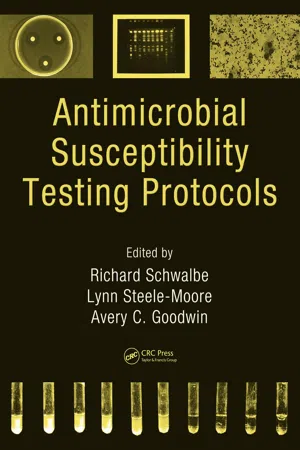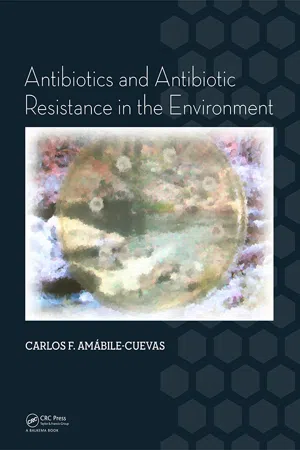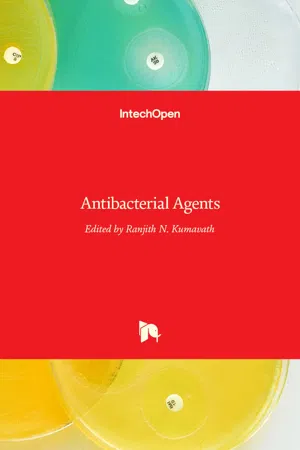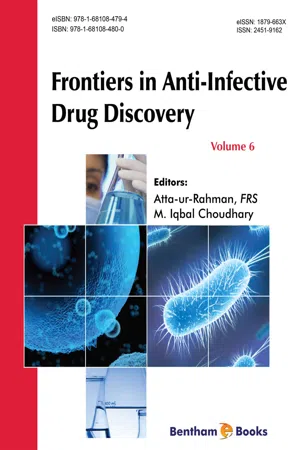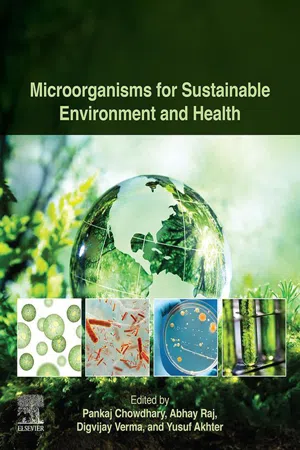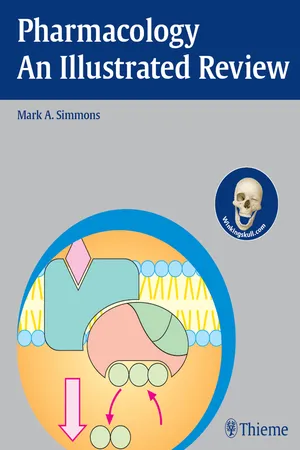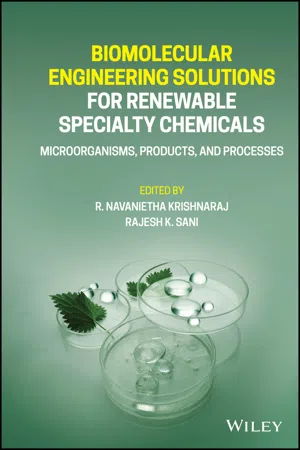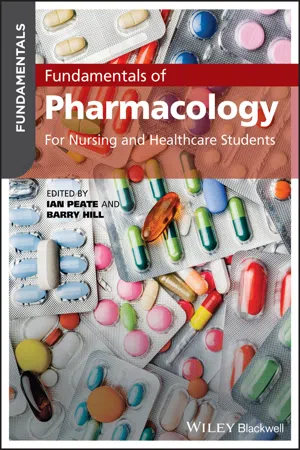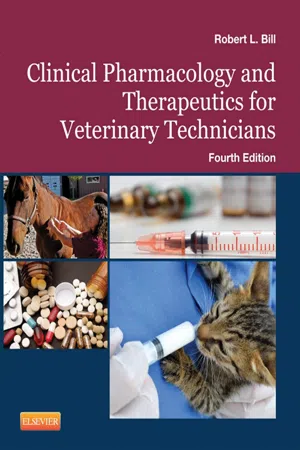Biological Sciences
Classes of Antibiotics
Classes of antibiotics are categorized based on their chemical structure and mechanism of action. Common classes include penicillins, cephalosporins, tetracyclines, macrolides, and fluoroquinolones. Each class targets specific bacterial components or processes, such as cell wall synthesis or protein production, making them effective against different types of bacteria. Understanding these classes is crucial for selecting the most appropriate antibiotic for treating bacterial infections.
Written by Perlego with AI-assistance
Related key terms
1 of 5
10 Key excerpts on "Classes of Antibiotics"
- Richard Schwalbe, Lynn Steele-Moore, Avery C. Goodwin(Authors)
- 2007(Publication Date)
- CRC Press(Publisher)
7 2 Antimicrobial Classifications: Drugs for Bugs Cassandra B. Calderón and Beulah Perdue Sabundayo CONTENTS 2.1 Introduction .............................................................................................................................. 9 2.2 Antibiotics ................................................................................................................................ 9 2.2.1 Penicillins ..................................................................................................................... 9 2.2.1.1 Background ................................................................................................... 9 2.2.1.2 Mechanism of Action .................................................................................. 12 2.2.2.3 Chemical Structure ...................................................................................... 12 2.2.2.4 Mechanisms of Resistance .......................................................................... 12 2.2.2.5 Classi fi cation ............................................................................................... 12 2.2.2.6 Antimicrobial Activity and Therapeutic Uses ............................................ 12 2.2.2.7 Adverse Effect Pro fi le ................................................................................. 14 2.2.3 Cephalosporins ........................................................................................................... 14 2.2.3.1 Background ................................................................................................. 14 2.2.3.2 Mechanism of Action .................................................................................. 14 2.2.3.3 Chemical Structure ...................................................................................... 14 2.2.3.4 Mechanisms of Resistance ..........................................................................- Carlos F. Amabile-Cuevas(Author)
- 2015(Publication Date)
- CRC Press(Publisher)
This definition would therefore include all drugs, of natural or synthetic origin, used against bacte-ria; and would exclude compounds used against viruses, fungi, protozoans or other microorganisms, as well as non-selective biocides, such as disinfectants and antiseptics. 1.1.1 Origin and mechanism of action of main antibiotic classes Although it is not within the purview of this book to enlist and review the origin and mechanism of action of each class of antibiotics, having an overview included could be helpful for the reader not well versed into this mainly pharmacological area. It may be important to point out that a sort of unifying mechanism of action of bactericidal antibiotics, through a common pathway of generating reactive oxygen species, recently proposed (Kohanski et al., 2007), was first shown to be inconsistent with physiological evidence (Mahoney and Silhavy, 2013), and then most likely to be based on a labo-ratory artifact (Renggli et al., 2013). It is also important to emphasize that these are the mechanisms of bacteriostatic or bactericidal effects of high, clinically-attainable concentrations of antibiotics; as will be discussed below, this could very well be a human-made situation, with natural antibiotics actually exerting other physiological roles at much lower concentrations. The following paragraphs enlist some relevant information about each antibiotic class, with those that include mostly natural prod-ucts first. For additional information on the chemistry, pharmacology and clinical uses of each drug, two comprehensive texts can be useful: Bryskier A. (ed.) Antimicrobial agents, antibacterials and antifungals ; ASM Press, Washington DC, 2005; and Grayson M.L. et al. (eds.) Kucers’ The use of antibiotics , 6th ed; Hodder Arnold, London, 2010.- eBook - PDF
- Ranjith N. Kumavath(Author)
- 2017(Publication Date)
- IntechOpen(Publisher)
It is aimed that this approach will be equally helpful for researchers, clinicians, and academicians. 2. Classification Infectious diseases are the major causes of human sickness and death. To overcome such health care issues, antibiotics proved to be promising agents ever since they were introduced in the 1940s. Antibacterials, which are a subclass of antibiotics, have been classified earlier in several ways; however, to make it more easily understandable, we can classify antibacterial agents into five groups: type of action, source, spectrum of activity, chemical structure, and function [1 ]. 2.1. Classification based on type of action Generally, antibacterials can be classified on the basis of type of action: bacteriostatic and bactericidal. Antibacterials, which destroy bacteria by targeting the cell wall or cell membrane of the bacteria, are termed bactericidal and those that slow or inhibit the growth of bacteria are referred to as bacteriostatic. Actually, the inhibition phenomenon of bacteriostatic agents involves inhibition of protein synthesis or some bacterial metabolic pathways. As bacterio‐ static agents just prevent the growth of the pathogenic bacteria, sometimes it is difficult to mark a clear boundary between bacteriostatic and bactericidal, especially when high concen‐ trations of some bacteriostatic agents are used then they may work as bactericidal [2 ]. Some prominent examples of bacteriostatic and bactericidal antibacterials along with their mode of action are presented in Table 1 . Antibacterial Agents 2 2.2. Classification based on source of antibacterial agents Antibacterials are the subclass of antibiotics, which can be naturally obtained from fungal sources, semi‐synthetic members which are chemically altered natural product and or syn‐ thetic. Cephalosporins, cefamycins, benzylpenicillin, and gentamicin are well‐known exam‐ ples of natural antibiotics/antibacterials. - Atta-ur-Rehman, M. Iqbal Choudhary, Atta-ur-Rehman, M. Iqbal Choudhary(Authors)
- 2017(Publication Date)
- Bentham Science Publishers(Publisher)
21 ]. Therefore, the need for new antibiotics against resistant bacteria is an ever-pertinent issue. As a result, scientists are attempting to produce and discover new antibiotics to overcome the issue of bacterial resistance to older antibiotics.In today's modern world, numerous classes of antimicrobial agents are known and classified based on their mechanisms of action [22 ]. Antimicrobial drugs are compounds that have selective toxicity against microbes; they target microbial cells while leaving the host relatively unharmed. Antibiotics are a subset of antimicrobial drugs, and were originally defined as substances produced by microorganisms that inhibit other microorganisms. Antibiotics (Greek anti, “against” and bios, “life”) are chemical compounds produced by living organisms. Dr. Selman A. Waksman, a soil microbiologist, suggested the noun “antibiotic” in 1942 [23 ]. Dr. Waksman and his colleagues discovered several actinomycetes-derived antibiotics in the following course of time [24 ].The nature of antibiotic substances has changed over time, from naturally to synthetically derived. At present, most antibiotics are manufactured synthetically or semi-synthetically, based on the structures originally identified from microorganisms. Semi-synthetic antibiotics are developed by including additional steps that modify naturally produced compounds, while synthetic antibiotics are developed entirely by chemical manufacturing processes [25 ].CLASSIFICATION OF ANTIBIOTICS
Antibiotics are classified depending on their origin, chemical structure, bacterial spectrum, or (most commonly) mechanism of action [26 ]. Some antibiotics inhibit bacterial cell wall biosynthesis (penicillins and cephalosporins); some cause disruption of the cellular membrane (polymyxins); and others inhibit the synthesis of nucleic acids and proteins (rifamycins, lipiarmycins, quinolones, and sulfonamides), disrupting the polymers that constitute bacterial cells (Fig. 2 ) [27 ].Fig. (2))- eBook - PDF
- N T Crosby(Author)
- 1991(Publication Date)
- Woodhead Publishing(Publisher)
BASIDIOMYCETES AND ASCOMYCETES LICHENS AND ALGAE 23 82 49 37 12 71 53 9 Korzybski el al. (1978). 86 Antibiotics [Ch. 4 broad to be much use for analytical chemists, since the majority of substances are derived from the genus Aclinomycetes. Furthermore, some compounds can be produced by different and unrelated genera. Equally, the same genus may produce more than one antibiotic. The activity spectrum is of prime importance to clinicians, and classifications based on biological properties are widely encountered. Antimicrobials are often described as being effective against Gram-positive or Gram-negative organisms, or against both. This refers to a classification of bacteria based on the organism's response when stained with a purple dye. The organism either retains or releases the dye on subsequent washings, so that Gram-positive organisms show up blue under the microscope whilst Gram-negative organisms appear red. Other classifications are based on differences in the mode of action of the active ingredient. Antibiotics are thought to function by interference in the synthesis and development of parts of the bacterial cell. They may prevent the formation of nucleic acids, or the synthesis of protein. Alternatively, they can attach themselves to the cell wall or cell membrane and prevent essential cross-linking of the structure or promote the ingress of ions, thus destabilizing the whole structure and eventually causing complete rupture. However, the mechanism of action of some antibiotics is not yet fully understood and it is possible that some compounds can act in more than one mode. Hence a classification based on chemical structure is increasingly becoming more popular, now that the molecular formulae of more and more compounds have been eluci-dated. For the analytical chemist, a classification based on chemical structure is clearly the most appropriate. 4.2.1 Chemical classification of antibiotics Antibiotics used in animal husbandry can be divided into the - Pankaj Chowdhary, Abhay Raj, Digvijay Verma, Yusuf Akhter(Authors)
- 2020(Publication Date)
- Elsevier(Publisher)
Antibiotics are mostly naturally occurring powerful medicines which are used for the treatment of many common diseases or infections caused by pathogenic bacteria. These infections include urinary tract infections, and respiratory tract infections (whooping cough, pneumonia, etc.), skin infections, and many others. They either kill bacteria or arrest their growth and keep them away from reproducing which is ultimately eliminated by body’s natural defense systems. In the early 1940s, the first antibiotics were introduced and since then millions of lives have been saved. Initially extracted from natural sources only, chemically synthesized antibiotics were introduced in the market later on. Natural antibiotics are nothing but secondary metabolites from bacteria. With time, different Classes of Antibiotics were either isolated or synthesized that adopt different modes of action on pathogens. Therefore different Classes of Antibiotics are potent against different types of bacteria. Some antibiotics, which are effective against wide range of pathogens, are called broad-spectrum antibiotics (aminoglycosides) and some that are more specific and effective against a few bacteria are called narrow-spectrum antibiotics (β-lactams). This chapter explains the different Classes of Antibiotics, their mode of action, and the common side effects of their improper use. It also highlights the past, present, and future of antibiotics.Keywords
Bacteriocidal; bacteriostatic; β-lactams; cephalosporins; macrolides; tetracycline; quinolones; aminoglycosides; chloramphenicol; sulfonamides; antibiotic resistance18.1 Introduction
Antibiotics are naturally occurring or synthetic antimicrobial molecules used against various parasitical ailments. They are not effective against fungal or viral infection but are in high demand for disease treatment caused by various bacterial infections. They work by blocking some crucial processes in microbial cells selectively (Walsh, 2004 ). Paul Ehrlich’s (1854–1915) work on the antibacterial effects of dyes can be defined as the beginning of modern era of antimicrobial chemotherapy. Ehrlich wanted to develop stains for histological examination of tissues. He found out that some bacteria are unable to survive in the presence of some stains. He focused himself to look for the chemical compound responsible for it. Ultimately, together with his team he was successful in isolating an arsenic-based compound called “salvarsan” which was very effective against Treponema pallidum , a causative agent for syphilis. This was the first chemical compound isolated which had significant antimicrobial property (Gould, 2016 ).18.1.1 A brief history of antibiotics
In 1909 a team of three scientists, Paul Ehrich, Sachachiro Hata, and Alfred Bertheim, discovered a compound called “salvarsan.” This was the first drug used against syphilis infection. In 1912 “neosalvarsan” was introduced which had less side effects compared to salvarsan. This was also used to cure syphilis infection.- eBook - PDF
- Mark A. Simmons(Author)
- 2011(Publication Date)
- Thieme(Publisher)
281 28 Principles of Antimicrobial Therapy 28 Principles of Antimicrobial Therapy Infectious diseases are caused by microbes or by microbial products. Antimicrobial drugs are intended to eliminate foreign organisms or abnormal cells from healthy tissues of the patient without comparable effects on the normal tissue cells of the host. This essential property of these drugs is called selective toxicity. 28.1 Classification of Antimicrobial Agents Chemical Structure and Mechanism of Action The main classification of antimicrobial agents is based on chemical structure (e.g., β-lactams and aminoglycosides) and mechanism of action (see Table 28.1 ). Table 28.1 ▶ Mechanism of Action of Antimicrobial Agents Mechanism of Action Drugs Inhibition of bacterial cell wall synthesis β-lactams: penicillins, cephalosporins, and carbapenems Others: cycloserine, vancomycin, and bacitracin Reversible inhibition of protein synthesis by disrupt-ing the function of 30S or 50S ribosomal subunits Bacteriostatic: chloramphenicol, tetracyclines, erythromycin, clindamycin, streptogramins, and linezolid Bactericidal: aminoglycosides Inhibition of nucleic acid metabolism by inhibiting RNA polymerase Rifampin and rifabutin Inhibition of nucleic acid metabolism by inhibiting DNA gyrase or topoisomerase The quinolones Inhibition of essential enzymes of folate metabo -lism (antimetabolites) Trimethoprim and sulfonamides Bacteriostatic or Bactericidal Antimicrobial agents are also classified according to whether they are bacteriostatic or bacte-ricidal ( Fig. 28.1 ). Fig. 28.1 ▶ Bacteriostatic versus bactericidal antibacterial agents. Bacteria are able to multiply in vitro in a growth medium if conditions are favorable. If the growth medium contains an antibiotic, the bacteria may be killed (bactericidal effect), or the bacteria may survive but are unable to multiple (bacteriostatic effect). 1 day Antibiotic Bacteriostatic Bactericidal - eBook - ePub
Biomolecular Engineering Solutions for Renewable Specialty Chemicals
Microorganisms, Products, and Processes
- R. Navanietha Krishnaraj, Rajesh K. Sani, R. Navanietha Krishnaraj, Rajesh K. Sani(Authors)
- 2021(Publication Date)
- Wiley(Publisher)
B. Bactericidal antibacterials Function β‐Lactam antibiotic: Penicillins, e.g. penicillin V, penicillin G, benzathine penicillin G, procaine penicillin G, cloxacillin, methicillin, oxacillin, flucloxacillin, and dicloxacillin β‐Lactam/β‐lactamase inhibitors: Carbapenems, e.g. meropenem, imipenem, aztreonam, piperaciintazobactam, and ticaracillinclvulnate; cephalosporins, e.g. ceftazidime, cefepime, ceftriaxone, and cefotaxime Interfere the synthesis of the bacterial cell wall Aminoglycosides: Gentamicin, amikacin, and tobramycin Protein synthesis inhibitors Quinolones and flouroquinolones: ciprofloxacin, oxifloxacin, and levofloxacin Block bacterial DNA replication Glycopeptide: Vancomycin Inhibit cell wall synthesis Polymyxins: Polymyxin B and colistin Disrupt bacterial cell membrane3.2.2 Classification of Antibiotics Based on the Spectrum of Action: Broad‐ and Narrow‐spectrum Antibiotics
Antibiotics can also be classified based on their targets: broad‐spectrum and narrow‐spectrum. The narrow spectrum antibiotics act against a narrow range of microorganisms and are genus or species specific. The broad‐spectrum antibiotics are effective against a wide range of pathogens including Gram‐positive and Gram‐negative strains. In general, if the causative agent of infection is known, the narrow spectrum antibiotics are preferred since they act specifically with the target bacteria and do not affect the normal commensal microbes in the body. Therefore, they have less ability to cause superinfection as well as antibiotic resistance. Table 3.2 depicts the diverse examples of broad‐ and narrow‐spectrum antibiotics (Acar, 1997 ). Broad‐spectrum antibiotics are very flexible drugs and are advantageous when the infectious microbes are not known or unidentified.3.3 Antibacterial Agents
Antibacterial agents are used to kill or inhibit the growth of pathogenic bacteria. Penicillins, cephalosporins, macrolides, fluoroquinolones, sulfonamides, tetracyclines, and aminoglycosides are the most effective antibacterial agents (Table 3.3 , Figures 3.1 –3.3 ) (Bertino Jr & Fish, 2000 ; Cheesman, Ilanko, Blonk, & Cock, 2017 ; Chopra & Roberts, 2001 ; Kołaczek, Fusiarz, Ławecka, & Branowska, 2014 ; Lima, da Silva, Barbosa, & Barreiro, 2020 - eBook - PDF
Fundamentals of Pharmacology
For Nursing and Healthcare Students
- Ian Peate, Barry Hill, Ian Peate, Barry Hill(Authors)
- 2021(Publication Date)
- Wiley-Blackwell(Publisher)
The goal of antibacterial therapy is to reduce bacteria (infection causing) to a point at where the body’s immune system can effectively deal with the microorganisms (Xiu and Datta, 2019). These drugs have certain properties: bactericidal, that is, they directly kill the bacteria; for example, peni-cillin and aminoglycosides; or, bacteriostatic, that is, they inhibit bacterial growth and rely on the body’s immune system to kill the bacteria; for example, tetracycline; or a combination of both properties; for example, aminoglycosides (Barber and Robertson, 2020; Ashelford, Raynsford and Taylor, 2016). The combination of bacteriostatic and bactericidal properties in certain drugs is due to the dosage and serum level concentration of the drug as well as outside influences and the health of the person. Narrow therapeutic index drugs, such as aminoglycosides, rely on the moni-toring of the serum concentration as this determines whether they lie within therapeutic range; the aim is to prevent underdosing or drug toxicity (Burchum and Rosenthal, 2019). As this chapter focuses on antibacterial agents, an understanding of bacteria cell structure and the various mechanisms of antibacterial action need to be considered. Antibacterials Chapter 9 155 Bacteria Bacteria are invisible to the naked eye, existing inside or outside organisms and they can live inde-pendent from a host (Barber and Robertson, 2020) (see Figure 9.1). Bacteria are single-cell microor-ganisms (prokaryotic) that have no nucleus but contain DNA (Ashelford, Raynsford and Taylor, 2016). They use their enzymes and ribosomes to manufacture proteins that allow their growth and reproduction to occur. Each bacterial type has a different shape: bacilli are rod-shaped, cocci are round-shaped and spirochetes are spiral/corkscrew-shaped (Barber and Robertson, 2020). Table 9.1 Classifications of antimicrobials with examples. - Robert L. Bill(Author)
- 2016(Publication Date)
- Mosby(Publisher)
9 Both of these safeguards make these newer drugs much safer to use and reduce the risk for mutations or birth defects in the veterinary patient. The newer antibiotics that work through this mechanism include the fluoroquinolones (eg, enrofloxacin, orbifloxacin).Classes of Antimicrobials
Every year new veterinary antimicrobial products are marketed for use against bacteria or other pathogens. Occasionally these drugs are brand-new Classes of Antibiotics, but more often they are simply repackaged versions of older drugs placed in a new dosage form or with an expanded target of microbes. Because of the constant stream of new antibiotics entering the veterinary medical market, keeping up with the new drugs can seem overwhelming. However, by understanding the basics of how each general class of antimicrobials works, the overall spectrum of activity for each class or group, and the mechanisms behind the key side effects, the veterinarian or veterinary technician should possess the necessary background to quickly understand what a new drug should be able to do and how it will work.Penicillins
Penicillins are among the most commonly used antibiotics in veterinary medicine and can usually be recognized by their -cillin suffix in the drug name. Because of a particular ringlike structure in their chemical composition, penicillins are also called beta-lactam , or β-lactam , antibiotics in reference to their β-lactam ring .
Index pages curate the most relevant extracts from our library of academic textbooks. They’ve been created using an in-house natural language model (NLM), each adding context and meaning to key research topics.
